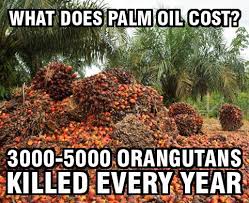PALM OIL PRODUCTION IS THREATENING MALAYSIAN ORANGUTANS
By Irene Cáceres
 These furry and intelligent primates that lived peacefully in the
jungles of Sumatra and Borneo are having difficult days. The deforestation
caused by palm oil industry is leaving them without their habitat or means to
survive.
These furry and intelligent primates that lived peacefully in the
jungles of Sumatra and Borneo are having difficult days. The deforestation
caused by palm oil industry is leaving them without their habitat or means to
survive.
The
orangutan habitat is limited to the islands of Sumatra that are part of
Indonesia and Borneo. This territory is divided between Malaysia, Indonesia
and Brunei. It is also the most arboreal primate. Its existence depends on the
rainforest jungle where they live in the wild.
The problem is that Malaysia and Indonesia are both major producers of
palm oil, these countries have become
the greatest enemies of orangutans by enabling the land for the plantations, and
they are destroying thousands of hectares of virgin forest. In the past decade
the population has dropped by 50%.
Currently there are only 20,000 specimens,
and it is estimated that the species could become extinct in a few years if
action is not taken.
80% of Indonesian forest has been burned or cleared to make way for
Elaeis guineensis, the palm species from which the oil is extracted.
Scientists
have concluded that although orangutans have adapted better than expected,
despite cases of malnutrition and conflict with the humans, the palm plantations
do not have capacity to accommodate large populations of primates.
 When a
forest is turned to agricultural land, orangutans lose living space and access
to funding sources. If they don’t want to die by the deforesting, they have to
migrate to seek refuge in neighboring jungles.
When a
forest is turned to agricultural land, orangutans lose living space and access
to funding sources. If they don’t want to die by the deforesting, they have to
migrate to seek refuge in neighboring jungles.
Besides,
clashes between apes and the crop workers are more frequent. Many are afraid of
orangutans and sometimes workers kill them, even though it is a protected
species. Even at this present era there are people who hunt them for meat. The
males have been used for centuries to combat burlesque boxing and females are
prostituted.
 Finally, if forest protection measures are not taken, there is no hope
for orangutans.
Finally, if forest protection measures are not taken, there is no hope
for orangutans.
According to Ancrenaz
"it is necessary for the palm oil industry to respect some areas of the
forests where orangutans live, so
that they may have mobility,
access to food and the chance to mate with individuals from other groups".
%2B06.46.34.png)



